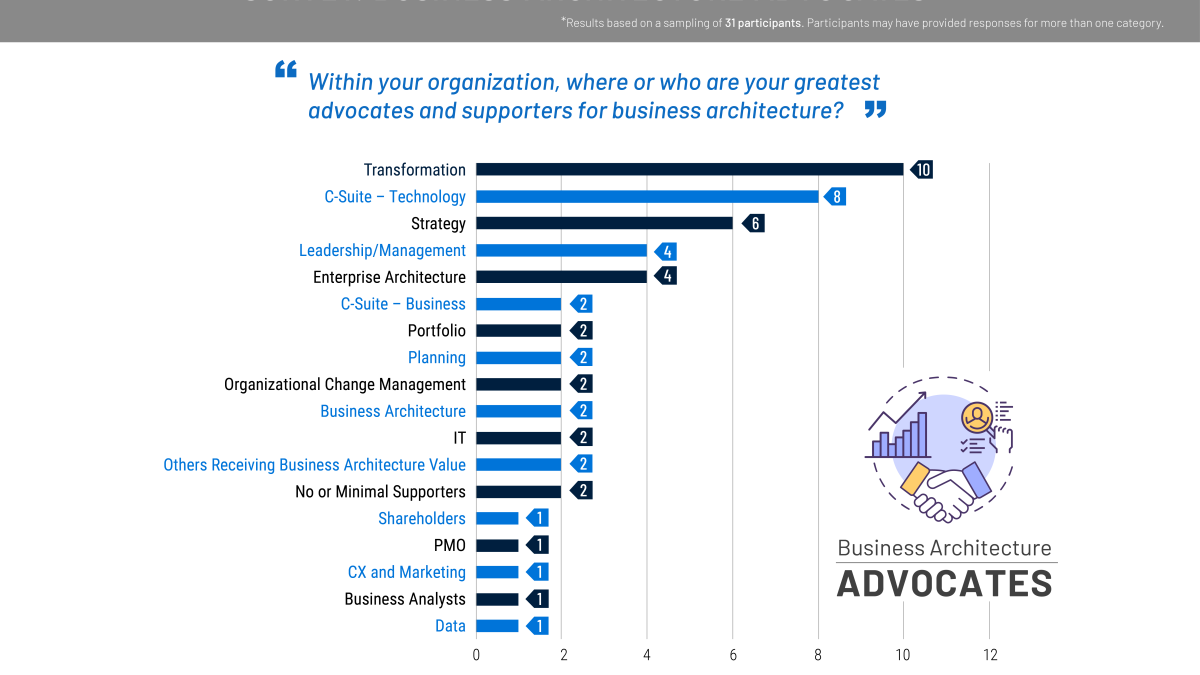This survey conducted among a small group of participants reveals, "Where or who are your greatest advocates and supporters for business architecture within your organization?" We synthesized the results from specific responses and anecdotes provided by the respondents. The top three advocate categories include transformation, CIOs/CTOs, and strategy. We believe this provides a good platform for business architecture, as these areas and roles are at the forefront of change – and in many cases, likely involve strategic and digital change.
Here are a selection of comments shared by participants for additional background and context:
- "Our advocates are in CX and Marketing." "100% Different brands, 570 unique domains in an APAC M&A environment."
- "Head Digital Reform (this is a new Senior Exec role within our group but not responsible for our division/section and also the new chair of group’s Investment Committee and group board member); Chief Architect and Enterprise Architects (in IT division within Corporate Group); Director Portfolio Support Team (our direct manager); Director of another Strategy Reform Office (a similar function within our group that we collaborate closely with) We have also recently gained approval from our group board to establish a design steering group under the board’s investment subcommittee which will have members who are directors from across the group who will (hopefully) endorse and champion our work."
- "We have supporters at Directors level in a few reform offices/teams within our business group, and are seeking someone higher up (Division head) as the advocate, so we can have the executives' ears. We have a business architect community of practice in place. Currently it is only comprised of a handful business architects across the group plus one enterprise business architect sits under ICT. Just recently ICT has adopted the BIZBOK Guide as the business architecture framework to be used. Sadly, adoption and uptake are two different things. Even within the BA CoP, there are different opinions."
- "We are at low maturity but connecting at the right spots. For example, we are plugged into the Demand Intake process and mapping all new strategic demands and their stakeholders to a published an accessible Level 2 capability map."
- "We have an enterprise architecture team with a business architect, a technical architect, and an information architect that sits in IT's Business Planning Office. That team is lead by a senior IT manager that reports to our CIO. The team is responsible for IT project management, IT communications, IT budgeting, and EA. EA is still a relatively new concept for us and our practice is slowly maturing, primarily on the business architecture side of things."
- We've moved Business Architecture from "Order Taker" to "Trusted Advisor."
- "The organization I work for right now is a very large,, and very complex organization, with multiple bus arch teams working independently, with different maturity level, different positionning, different leadership. One biz arch team is composed of 80+ bus arch (more business analyst than Bus Arch) tackling multiple transformational IT driven projects but not fully realizing that it is transformational - tactical approach and focus on delivery. Another one is headed by a strong leader and a VP who acts as a strong advocate - Bus Arch is seen and valued as a real bus partner that you want to pair up with when tackling large changes (IT) still. Another one as 15-20 bus arch focusing on digital transformation sprints focused on specific customer journeys, doing modelling. Another one has a new team of young and relatively limited experience bus arch responsable for delivering IT positionning statements (bus arch - impacts analysis, as is versus to be models), but also trying to support the strategy team in modeling the future "distribution" bus Arch models. There is a practice leader trying to establish standards and facilitate experience, knowledge sharing through lunch and learn...with limited success. There are attempts (getting some traction) to establish a string complicity - partnership with the enteprise architecture team. There are encouraging signs of synergies and share willingness to better equip the execs teams so they can better "govern" the 10 organization wide transformational changes with the help of bus arch levers."
- "Inconsistent practices across organization. Not all business architects have same knowledge of best practices. Role is seen as a step up from IT architecture or business analysis and missing business knowledge."
- "The business architecture practice is very immature. Several people have the title of business architect across the organization, but they don't work together and most of them are doing business architecture as a discipline."
- "Business Architecture is under EA head with highly technical view of things. On the positive side, business architecture provides the context that EA needs to execute technical strategy, however, on the flip side, we do lack buy in from the business and also have little access to the business as we are perceived as the "IT Technical Team" as opposed to "Trusted Advisors" whom we can partner with."
- "Most people don't understand business architecture, it's benefits or use. Even the EAs who need to work with us have varying levels of understanding, but they themselves struggle to get buy-in to work with us. It really feels like a losing battle. So far most of the stakeholders who bought into it, has left the organisation since."
- "Our business architecture has withered from re-orgs following the "great resignation" -- but it was not particularly strong before the pandemic."
- "The BA team is now defunct- To protect the BA we all merge with the EA team. The new CIO doesn’t understand or believe in having BA specialists at the EA level."
